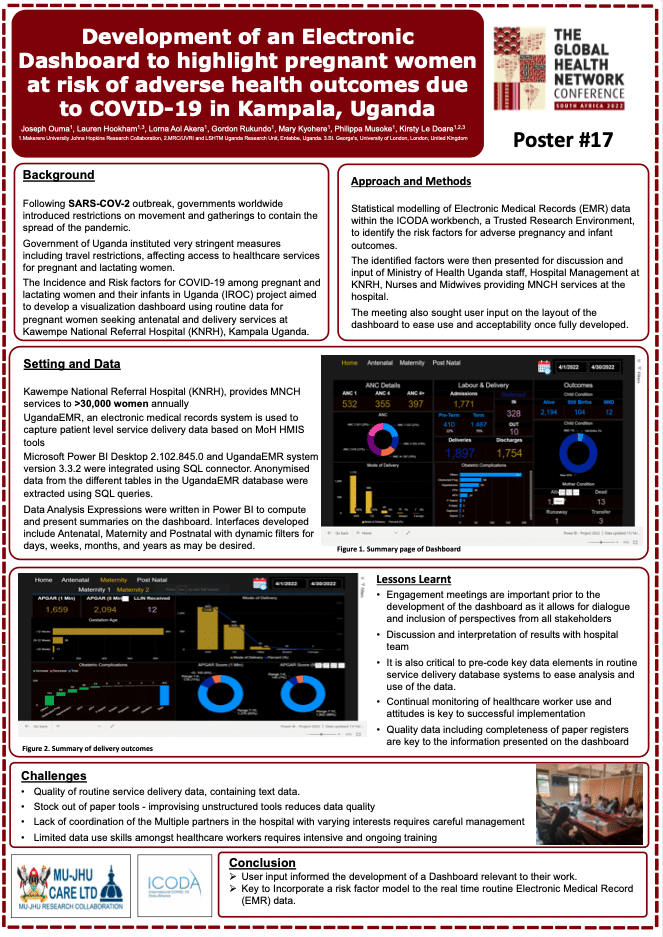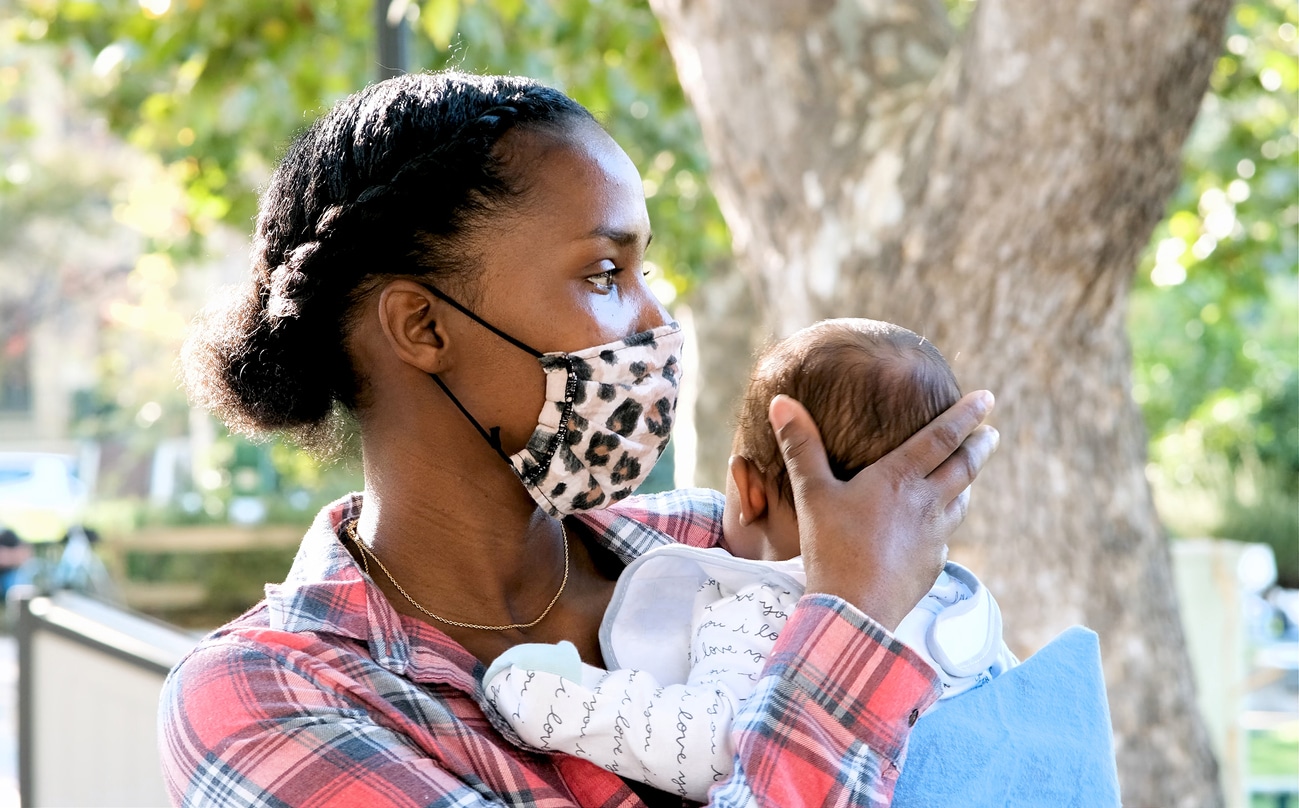Driver Project 10 - Incidence and Risk Factors for COVID-19 Amongst Pregnant and Lactating Women and their Infants in Uganda
To improve maternal, neonatal, and child health in Uganda and Kenya during pandemics by using a modelling approach on existing data from 30,000 pregnancies to identify risk factors for adverse outcomes.
Kirsty Le Doare and colleagues at the MRC/UVRI & LSHTM Uganda Research Unit and Makarere University John’s Hopkins University in Uganda have developed a model using data collected in real-time to identify the risk factors for adverse pregnancy and infant outcomes caused by the COVID-19 pandemic that can be used to rapidly inform interventions. Lockdowns can severely impact women giving birth and access to maternal, neonatal, and child healthcare. They applied a Bayesian multivariate network meta-analysis, (a methodology that simultaneously analyses multiple outcomes and multiple treatments, allowing more studies to contribute towards each outcome and treatment comparison) to electronic medical records, leveraging existing data on the effect of the lockdown on antenatal and delivery services for over 30,000 pregnancies, vaccination data, and information on COVID-19 infection in pregnancy and infancy. They also built a user-friendly data dashboard to support decision-making on infection prevention and control at the Ministry of Health.
| Title | Journal | Date |
Type | Abstract |
|---|---|---|---|---|
| Using electronic medical records to understand the impact of SARS-CoV-2 lockdown measures on maternal and neonatal outcomes in Kampala, Uganda | PLOS Global Public Health | Dec-23 | Publication | The DP-IROC team investigated the use of EHR to assess risk factors for adverse pregnancy and infant outcomes that can be incorporated into a data visualization dashboard for real time decision making during pandemics. This study analysed data from the UgandaEMR collected at pre-, during- and post-lockdown timepoints of the COVID-19 pandemic to determine its use in monitoring risk factors for adverse pregnancy and neonatal outcomes. |
| Title | Type | Description |
| Dataset dictionary | Metadata | The antenatal and labour & delivery registers used by healthcare workers to record patient information while offering services at the hospital were reviewed to identify variables included in the registers. The registers are part of the Health Management Information System tools developed by Ministry of Health and are used in all health facilities country-wide. |
| Incidence and Risk Factors for COVID-19 for pregnancy and infants, Uganda | Metadata |
The research was a secondary analysis of data collected among women who received antenatal and delivery services at Kawempe National Referral Hospital in Kampala, Uganda
|
| Title |
Description |
|
| Watch: ICODA webinar Series: Privacy Enhancing Technologies (PETs): The use of Trusted Research Environments in global health research |
Joseph Ouma, Senior Programmer for the periCOVID study, Makarere University Johns Hopkins University (MUJHU), Uganda, and the IROC study will describe his team’s experiences of using TREs in their research projects.
|

|
| Poster: Development of an Electronic Dashboard to highlight pregnant women at risk of adverse health outcomes due to COVID-19 in Kampala, Uganda | Poster presented at The Global Health Network conference in Cape Town 2022 | 
|
IROC Video transcription
Video transcription
Our project basically intends to assess the indirect effects of the COVID-19 pandemic on Mothers, women, mothers who are attending or accessing continental labour and delivery and postnatal services at COVID National referral hospital in Uganda.
So, basically we would like to assess the indirect effects of the COVID 19 pandemic on the services in the hospital. So we are using data from the National referral hospital in Uganda. Data that’s collected among the women and then mothers who at the same time on the maternal and child health care services at Columbia national referral hospital. This will comprise data on the adverse outcomes of pregnancy, so including things like maternal deaths, neonatal deaths, prematurity at stillbirth, miscarriages, pre-eclampsia and haemorrhages.
We also going to use data on lockdown measures that were taken in Uganda from the start of the pandemic to date. And so therefore we use that to model and be able to answer our research questions.
Since the start of the project, our main challenge has been the sub granting process. The grant was awarded to London School of Hygiene and Tropical Medicine in Uganda with Module research collaboration as a sub grantee. However, most of the work is being carried out at Mutu and therefore implying that policy has to supplant the work to research collaboration. And the process of realising the sub granting process has been diffucult and therefore has effect affected are getting the data, the data class on board and to begin the data cleaning process.
Yeah, at the end of the project we hope to particularly be able to identify service utilisation and gaps that may be as a result of a pandemic in Uganda. And this information will therefore be able to help healthcare providers to decide to what interventions might be necessary such as the vaccination, catch up programmes, or any other programmes that they might be, or might want to implement as after follow following a pandemic.
So, basically, the data that this work will be able to answer such questions such as what are the key populations that have gaps in service utilisation and who are the people that require a specific you know, special interest or special attention for pandemic? Now this data will also be utilised by government to develop policies or guidance for future pandemics. Given the challenges that we’ve had, we’ve had a bit of delays in cleaning our data, and therefore this has caused us to lag a bit behind but we hope by March 2022 a first set of results will be available for sharing.
The field of data science is using a lot of data generated from services, routine service data, and key among this is really how do we pull together this large volumes of data to inform service delivery. The other key issue the where are these open platforms or secure open platforms that can be used in a collaborative manner to answer key research questions that are facing humanity at the moment. So using routine data is key and also where they open open research platforms that can securely utilise our data.
Sharing the data or user data in that platform would help in such a way that we are learning from other you know, grantees or, you know, individuals in other settings of what are the key important, you know, questions to ask that we the kind of data we have but also what are the key things or key considerations to make when we’re answering this site questions. And, the other thing is that we are able, with collaborating, sharing this data with others, we’ll be able to develop or come up with solutions that are scalable to other settings


